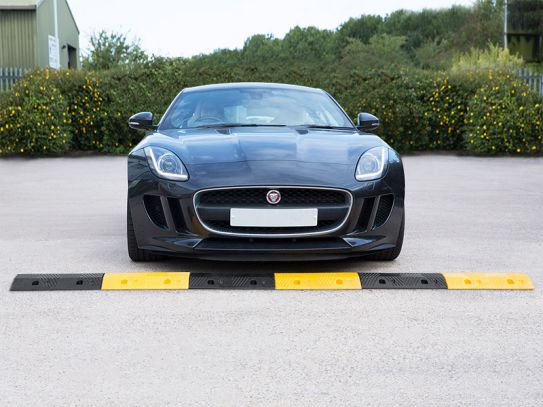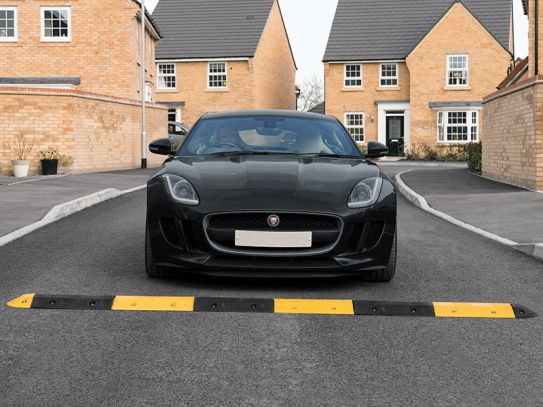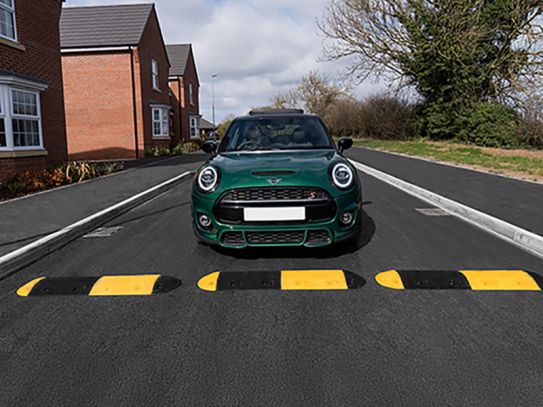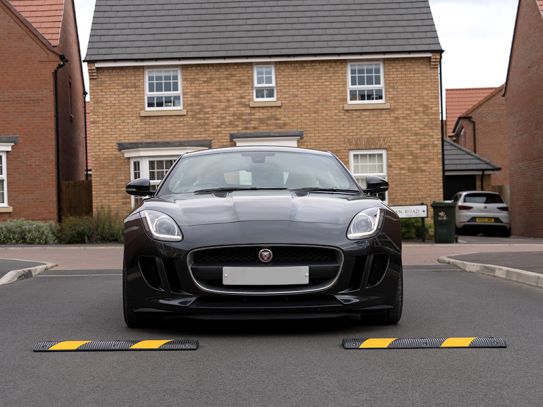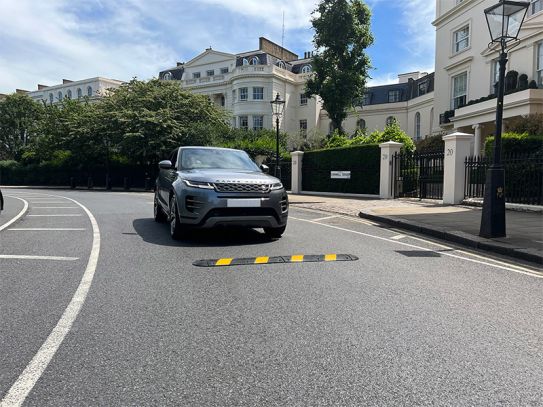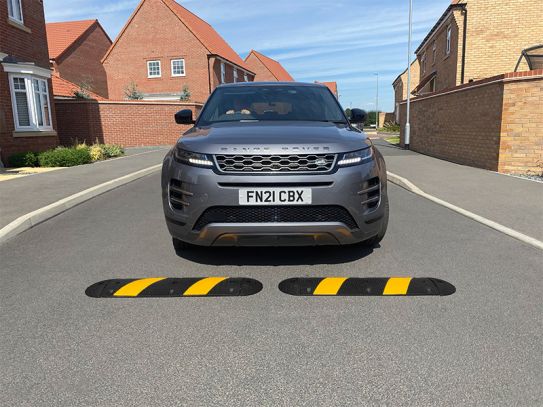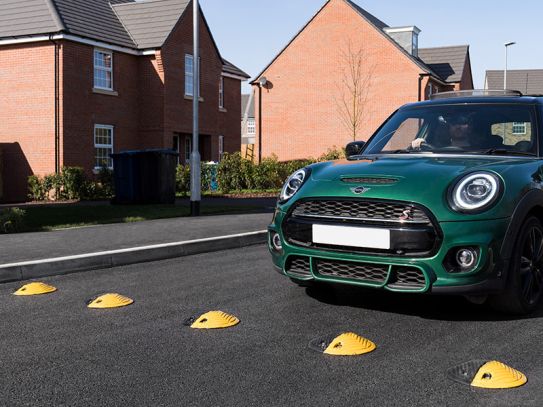Speed Bumps
Speed bumps are an integral part of any speed or traffic calming management scheme. Whether you require short-term control or lasting fixtures, The Workplace Depot has the right solution for you. Made from heavy duty rubber, our 5mph and 10mph kits can be used as either a permanent or temporary speed management option.
Slow Down and Stay Safe with Our Rubber Speed Bumps
Are you tired of speeding cars and reckless drivers ruining the peace and safety of your neighbourhood? Our range of rubber speed bumps is here to help! Made of durable, high-quality rubber, these speed bumps are designed to slow down traffic and keep your roads and parking lots safe. Plus, they're easy to install and require minimal maintenance, making them a cost-effective choice for any property. Don't let speeding cars endanger your community - trust in our range of rubber speed bumps to keep your roads and parking lots safe.
What Is a Speed Bump?
A speed bump is a section of road with a gradual slope that is designed to slow down vehicles as they travel over it. Speed bumps are typically used in residential areas and near schools to reduce the speed of passing vehicles and improve safety for pedestrians and other road users. They are also known as speed humps or speed ramps.
How Do Speed Bumps Work?
Speed bumps work by forcing vehicles to slow down as they pass over them. As a vehicle travels over a speed bump, the front wheels will rise up the slope of the ramp, causing the vehicle to lose some of its forward momentum. The steeper the slope of the ramp, the more dramatic the slowdown will be. Once the vehicle has reached the top of the ramp, its wheels will drop back down to the level of the road, allowing it to resume its normal speed.
In addition to slowing down vehicles, speed bumps also serve as a visual cue to drivers to reduce their speed. The raised section of the road is often painted with bright colours or marked with reflective materials to make it more noticeable to drivers. This can help remind drivers to slow down and be more cautious in the area.
Where Are Speed Bumps Typically Used?
Speed bumps are typically used in residential areas and near schools, where there is a need to reduce the speed of passing vehicles to improve safety for pedestrians and other road users. In these areas, the presence of pedestrians, children, and other vulnerable road users makes it important to reduce vehicle speeds to prevent accidents and injuries.
Speed bumps are also commonly used in areas with heavy through traffic, where there is a risk of drivers ignoring local speed limits and endangering the safety of residents. By forcing drivers to slow down as they pass over the speed bump, these measures can help to reduce the risk of accidents and improve safety for everyone on the road.
Additionally, speed bumps may be used in areas with a history of speeding and other traffic violations, as a way to discourage drivers from breaking the law and to promote safer driving habits.
Why Are Rubber Speed Bumps a Good Choice?
Rubber speed bumps have several advantages over other materials, such as asphalt or concrete. One of the main benefits of using rubber is that it is more forgiving than hard surfaces, making it less likely to cause damage to vehicles or injury to pedestrians if they are hit by a car.
Rubber speed bumps are also more flexible and less susceptible to cracking or breaking under heavy loads or extreme temperatures. This makes them more durable and long-lasting than other types of speed ramps, which can save money on maintenance and repair costs over the long term.
In addition, rubber speed bumps are often quieter and smoother than other materials, which can reduce noise pollution and make the road surface more comfortable for vehicles and pedestrians. Some rubber speed bumps are also designed to be more visible and easier to see at night, which can improve safety in low-light conditions.
What Are the Maintenance and Care Requirements for Speed Bumps?
The maintenance and care requirements for rubber speed bumps will depend on a variety of factors, including the age of the bumps, the amount of traffic they are subjected to, and the weather conditions in the area. In general, however, rubber speed bumps require relatively little maintenance and can be kept in good condition with regular cleaning and inspections.
One of the main maintenance tasks for rubber speed bumps is to keep them clean and free of debris. Over time, rubber speed bumps can become covered in dirt, leaves, and other debris, which can make them less visible to drivers and potentially cause accidents or damage to vehicles. To keep rubber speed bumps clean, they can be swept or blown with a leaf blower to remove loose debris, and then washed with a hose or pressure washer to remove any remaining dirt or grime.
In addition to cleaning, it is also important to regularly inspect rubber speed bumps for signs of wear or damage. Over time, rubber speed bumps may become worn or damaged due to exposure to the elements or heavy traffic. If a rubber speed bump is damaged, it may need to be repaired or replaced to maintain its effectiveness.
What Are the Benefits and Drawbacks of Using Speed Bumps to Control Traffic Speed?
The main benefit of using speed bumps to control traffic speed is that they can help to reduce the risk of accidents and improve safety for pedestrians and other road users in residential areas and near schools. By forcing drivers to slow down as they pass over the speed bumps, these measures can help to reduce the likelihood of collisions and injuries.
Speed bumps can also be a useful tool for managing traffic flow in areas with heavy through traffic or a history of speeding and other traffic violations. By encouraging drivers to reduce their speed, speed bumps can help to improve the flow of traffic and reduce the risk of congestion and delays.
However, there are also some drawbacks to using speed bumps to control traffic speed. One of the main drawbacks is that they can cause inconvenience and frustration for drivers, who may have to slow down significantly as they pass over the bump. This can lead to increased traffic congestion and delays, especially if there are multiple speed bumps on the same road.
In addition, speed bumps can cause discomfort for passengers in vehicles, especially if the bump is steep or the vehicle is travelling at a high speed. This can be especially problematic for people with medical conditions that make them sensitive to sudden changes in motion, such as pregnant women or individuals with back or neck injuries.
Are There Alternative Methods for Controlling Traffic Speed?
There are several alternative methods for controlling traffic speed that may be more or less effective than speed bumps. Some of the most common alternatives include:
- Roundabouts: These are circular intersections that force vehicles to slow down and yield to other traffic as they enter and exit the circle. Roundabouts can be effective at reducing speed and improving safety, but they may require more space and can be confusing for some drivers to navigate.
- Speed cameras: These are cameras that are installed at strategic locations along the road and are used to automatically detect and ticket vehicles that are speeding. Speed cameras can be effective at reducing speeding and improving safety, but they may be expensive to install and maintain, and some drivers may be resistant to being monitored and ticketed.
- Traffic calming measures: These are a variety of techniques and devices that are used to slow down traffic and improve safety, such as narrowing the road, installing raised crosswalks, or using traffic islands or chicanes. Traffic calming measures can be effective at reducing speed, but they may require more space and can be disruptive to traffic flow.
How Do Speed Bumps Affect Vehicle Handling and Safety?
Speed bumps can affect vehicle handling and safety in a number of ways. As a vehicle passes over a speed bump, the front wheels will rise up the slope of the ramp, causing the vehicle to lose some of its forward momentum. This can make the vehicle more difficult to control and may require the driver to make adjustments to the steering, braking, or acceleration to maintain a safe speed.
If a vehicle is travelling too fast as it approaches a speed bump, it may be unable to slow down enough to safely negotiate the ramp. This can cause the vehicle to lose control and potentially result in a collision or accident. In some cases, the sudden change in speed and elevation may also cause discomfort or motion sickness for passengers in the vehicle.
Speed bumps can affect vehicle handling and safety in both positive and negative ways. While they can help to reduce speed and improve safety for pedestrians and other road users, they can also create challenges for drivers and may cause discomfort for passengers. It is important for drivers to approach speed bumps with caution and to reduce their speed as necessary to maintain control of their vehicle.
How Do Different Types of Vehicles Respond to Speed Bumps?
Different types of vehicles may respond differently to speed bumps, depending on their size, weight, and speed. In general, however, all vehicles will experience some degree of slowdown as they pass over a speed bump, due to the slope of the ramp and the loss of forward momentum.
- Cars and other small vehicles will typically slow down more significantly as they pass over a speed bump, due to their lower weight and higher centre of gravity. This can make it more difficult for drivers to maintain control of the vehicle and may cause discomfort for passengers.
- Trucks and other large vehicles, on the other hand, may experience less of a slowdown as they pass over a speed bump, due to their greater weight and lower centre of gravity. This can make it easier for drivers to maintain control of the vehicle, but may also cause more damage to the road surface if the vehicle hits the bump at high speed.
- Motorcycles and other two-wheeled vehicles can be especially sensitive to speed bumps, due to their narrow wheels and high centre of gravity. If a motorcycle hits a speed bump at high speed, it may be more likely to lose control and potentially cause an accident. For this reason, it is important for motorcycle riders to approach speed bumps with caution and to reduce their speed as necessary to maintain control of their vehicle.
What Are the UK Legal Requirements and Regulations Surrounding the Use of Speed Bumps?
In the United Kingdom, the legal requirements and regulations surrounding the use of speed bumps are set by the Department for Transport (DfT). These regulations are designed to ensure that speed bumps are used safely and effectively to reduce traffic speed and improve road safety.
According to the DfT, speed bumps must be marked with reflective materials or painted with bright colours to make them more visible to drivers. They must also be placed on the road in a way that does not obstruct traffic or cause excessive delays.
The DfT also provides guidelines for the design and construction of speed bumps, including recommendations for the height, width, and length of the bumps, as well as the materials that should be used. These guidelines are intended to help local governments and other organisations make informed decisions about the use of speed bumps in their areas.
Have There Been Any Studies on the Effectiveness of Speed Bumps in Improving Safety?
Yes, there have been several studies and research projects on the effectiveness of speed bumps in reducing traffic speed and improving safety. These studies have generally found that speed bumps can be an effective tool for slowing down traffic and reducing the risk of accidents, particularly in residential areas and near schools.
For example, a study published in the Journal of Transportation Engineering in 2002 found that speed bumps were effective at reducing vehicle speeds on residential streets. The study, which was conducted in the United States, found that the average vehicle speed on streets with speed bumps was reduced by about 10-15%, compared to streets without speed bumps.
Another study, published in the journal Accident Analysis and Prevention in 2008, found that speed bumps were effective at reducing the number of accidents and injuries on residential streets in the United Kingdom. The study found that the use of speed bumps was associated with a 25% reduction in the number of accidents involving pedestrians and a 40% reduction in the number of accidents involving children.
